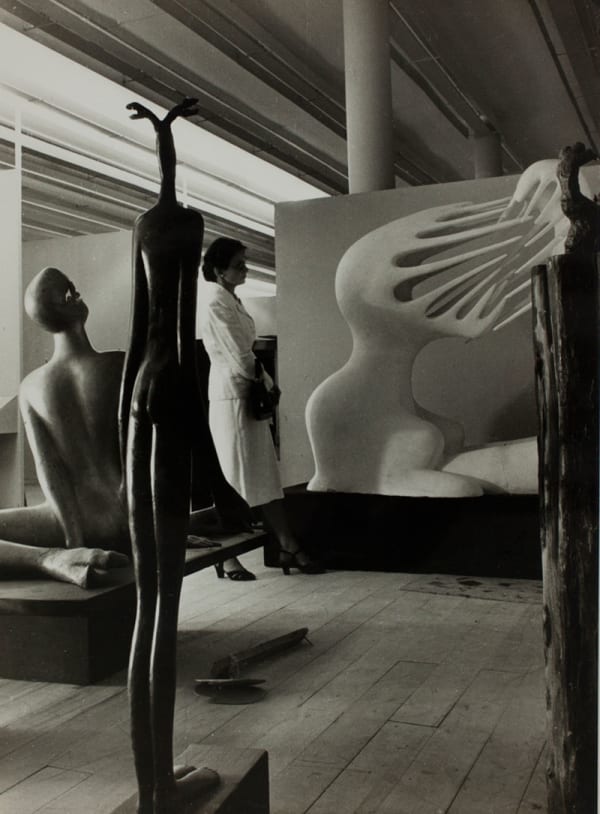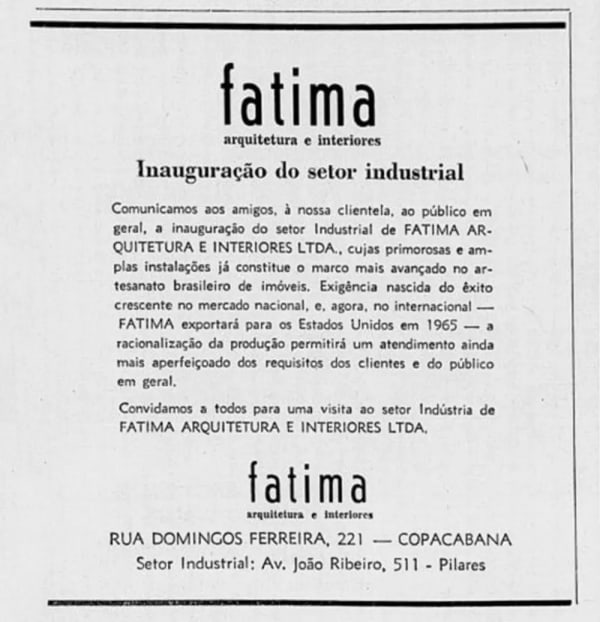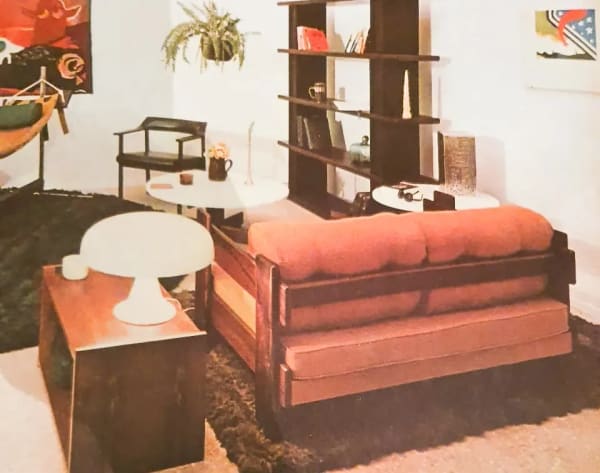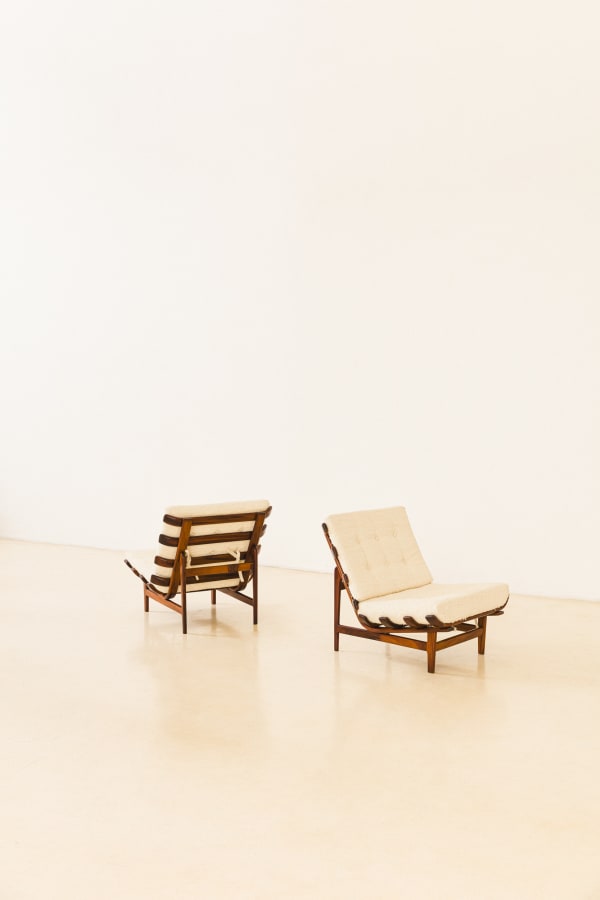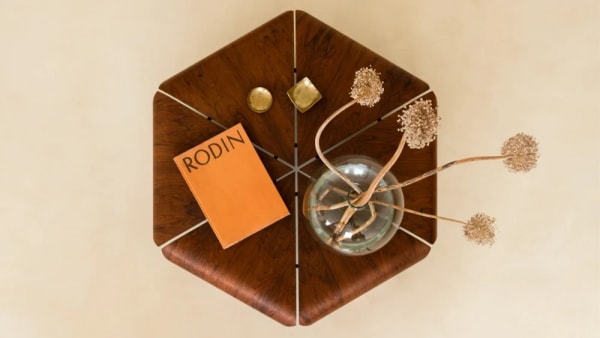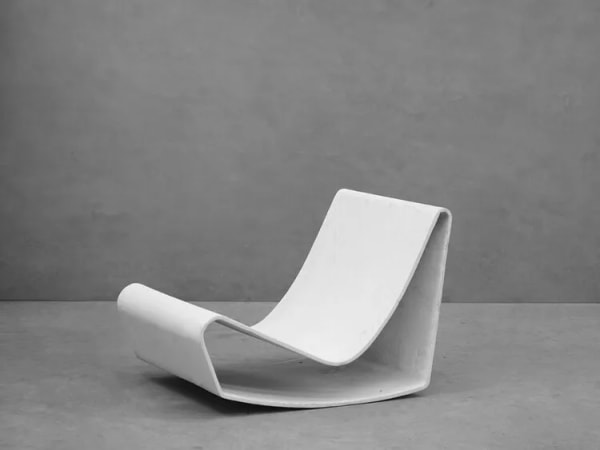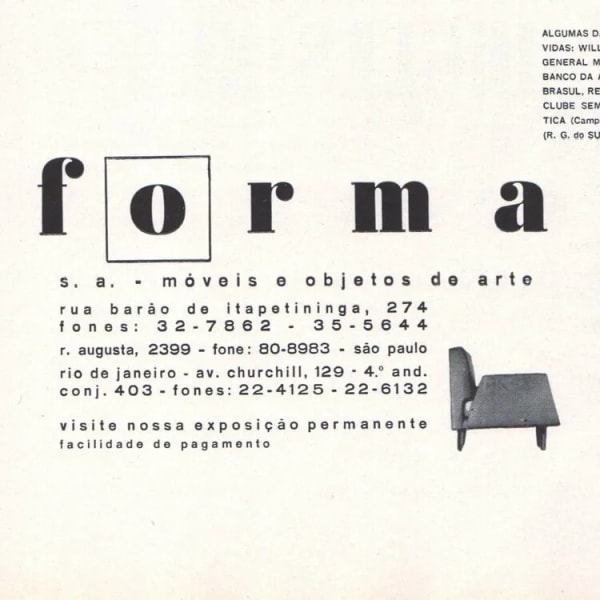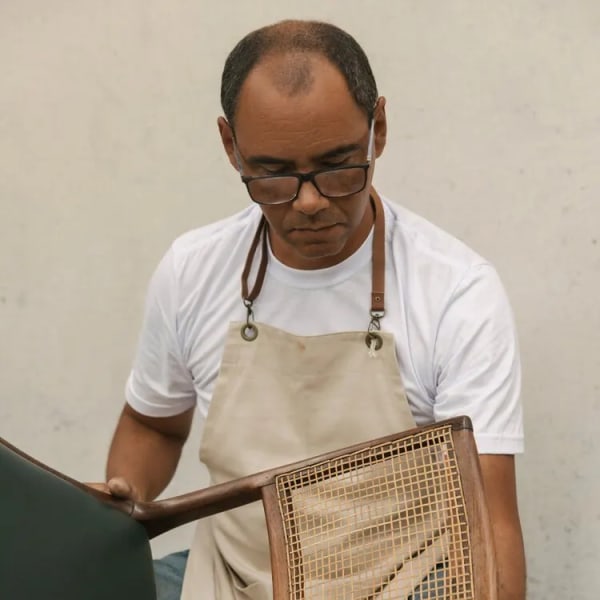-
-

Inside the Collection - Gautherot and Pedregulho
Designed by Affonso Eduardo Reidy, the Pedregulho housing complex in São Cristóvão, in the northern zone of Rio de Janeiro, stands as a landmark of Brazilian architecture.
-

Bienal de São Paulo
The Bienal de São Paulo reflect how Brazil has imagined itself in dialogue with the world over more than seventy years. Each design captures a moment, not only in the evolution of graphic language but also in the broader shifts of politics, society, and art.
-

Hidden Treasures: Móveis Cimo
More than just an industry, Móveis Cimo left an enduring legacy in Brazilian design history. It furnished public buildings, theaters, cinemas, and schools while also catering to the growing demand for modern design in private homes. As "modern" became synonymous with "trendy," Cimo developed a line that brought mid-century aesthetics to a broader audience, balancing functionality with style.
-

Hidden Treasures: Celina Decorações
Celina Decorações, a Rio de Janeiro-based company active from the 1950s to the 1980s, played a pivotal role in Brazilian modernist furniture design. It was originally founded as a small upholstery shop in 1938 by Celina Zilberberg, hence the company's name - a tribute made by her son, Munis Zilberberg. He transformed the small shop into a modern enterprise that emphasized quality, artisanal craftsmanship, and functionality.
-

Hidden Treasures: Cantù Móveis
Cantù Móveis e Interiores Ltda., a notable player in Brazilian modern design during the 1960s, was led by architects Jorge Jabour Mauad and Osires Cunha Meale. Their designs masterfully blended rosewood with marble, leather, and exclusive national fabrics, positioning Cantù as an industrial furniture producer that moved beyond artisanal methods while still offering customizable, modular pieces for homes and offices.
-

Hidden Treasures: Fátimas Arquitetura e Interiores
Founded in Rio de Janeiro during the 1960s by architects Guilherme Nunes and Sávio Visconti, Fátima Arquitetura e Interiores LTDA. (FAI) created a unique space where architecture, decoration, and art converged. The company’s gallery served as a platform for artistic expressions tied to architectural principles, enriching the local creative scene.
-

Hidden Treasures: Casulo
Casulo is a well-hidden treasure, yet to be fully uncovered. So far, we haven’t been able to find any additional information about the company, its designers, or other pieces it may have produced, beyond the ones we present in this selection. Remarkably, with just a single image and reference, we were able to identify and catalog four pieces: a chair with armrests, a sofa and armchairs set, and a hammock.
-

Hidden Treasures: Licei de Artes e Ofícios
The Liceu de Artes e Ofícios de São Paulo is a historic institution, with a legacy that dates back to its founding in 1873, having played a pivotal role in advancing woodworking craftsmanship and technical expertise in Brazil. Established to train skilled artisans, it significantly influenced São Paulo's industrial and cultural development during the late 19th and early 20th centuries.
-

Hidden Treasures: Móveis Pailar
Brazilian Rosewood and Gonçalo Alves are renowned for their distinct visual characteristics and historical significance in Brazilian craftsmanship. Brazilian Rosewood (Dalbergia nigra) is known for its deep reddish-brown hues with dramatic black streaks, creating a striking yet balanced aesthetic. Its rich tonal variations and natural luster made it a preferred material for fine furniture, musical instruments, and decorative applications.
-

Lina Bo Bardi, architecture and design democratizing modern ideas through the industry
Lina Bo Bardi (1914-1992) believed in the industry as a vehicle for democratizing modern ideas and promoting the social and cultural potentials of architecture and design. Effortlessly combining industrialized production with sensible solutions, Bo Bardi's furniture, like her general practice, was playful and accessible yet deeply rooted in the history of modernism and design. That way, she brought Brazilian culture, territory, and history into her creations.
-

JORGE ZALSZUPIN: notes about the master's viewing room
Celebrating the Jorge Zalszupins memorable production, in December 2022, we presented a Viewing Room with a selection of essential works developed over years of research and technical experimentation.
-

Sitio Burle Marx
Last week Sítio Roberto Burle Marx was selected as world heritage under the cultural landscape category by the United Nations Organization for Education, Science, and Culture (Unesco). It is the 23rd Brazilian location on the world heritage list.
-

Guhl's Loop Chair
Willy Guhl (1915–2004) is the Pioneer of Industrial Design Switzerland. He founded the first Swiss course of studies in product design at the Kunstgewerbeschule Zürich (today ZHdK). He taught for thirty years while also designing products for the industry on a regular basis.
-

Biographical Notes: de Barros
Geraldo de Barros (Chavantes, 1923 — São Paulo, 1998) was a Brazilian artist and designer who worked with painting, photography, engraving, graphic arts, and industrial design.
-

Forma S.A.
Legally, the company Forma S.A. Móveis e Objetos de Arte (Forma S.A. Furniture and Art Objects) was registered on 24 January 1956, but its activities had begun since 24 June 1955.
-

Biographical Notes: Martin Eisler
Martin Eisler was born in Vienna, in 1913, and graduated in architecture in 1936, where he had contact with Bauhaus professors.
-

Biographical Notes: Carlo Hauner
Carlo Hauner was born in Brescia, Itália, in 1927. He graduated in technical and artistic design at the Academy of Brera, Milan. In 1948, in his early twenties, he participated at the Biennale di Venezia (International Architecture Festival), and migrated to Brazil.
-

Amauri, the woodmaster
"Hands of Restoration" is a three-chapter series, intends to present the artisans responsible for the multiple processes involved in the restoration of modern furniture. The third Chapter presents Amauri, responsible for bringing back the beauty of Brazilian woods; found on most pieces of 1950 and 1960 design production.
-

Móveis Artesanal
The company Móveis Artesanal was a pioneer in the country in allying with success to a design office with a modern language, and with a serial system of fabrication in innovative commercial spaces. Founded by Carlo Hauner in 1950, who later partnered with Martin Eisler and Ernesto Wolf, Artesanal sold furniture designed by the first two, as well as some pieces created by Ernesto Hauner in other shops.
-

-

Mocho, the simplicity and elegance of Sergio Rodrigues stool
Sergio Rodrigues (1927-2014), designer and architect from Rio de Janeiro, opened Oca, both a gallery and a store, in 1955, at the heart of Ipanema. Rio de Janeiro in the 1950s was already a great metropolis, the brain and the heart of Brazil. Few things are as Brazilian as the oca, from the Tupi word ‘oká,’ and the Guarani word ‘Oca,’ which is an indigenous house made entirely of natural materials.
-

